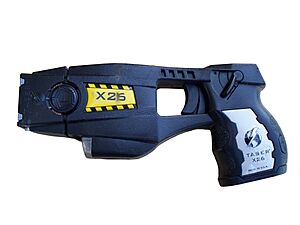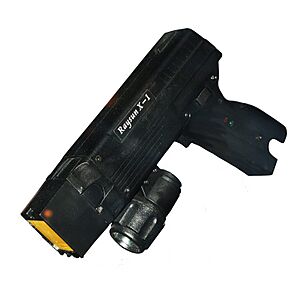Taser facts for kids

A TASER is a special device that uses electricity to stop people from moving. It's called a conducted energy device (CED). The main goal is to make someone unable to resist. This allows them to be handled more safely.
TASERs are sold by a company called Axon. This company used to be known as TASER International. A TASER works by shooting two small darts. These darts have barbs, which means they are designed to stick to a person's skin.
The darts travel very fast, about 55 meters per second. They stay connected to the main TASER unit by thin wires. These wires send a special electric current. This current is designed to affect a person's muscles. It causes "neuromuscular incapacitation." This means it makes it hard for a person to control their own muscles.
Sometimes, a TASER might just cause local pain. Other times, it can cause strong, uncontrolled muscle movements. How it affects someone depends on how it's used. It also depends on how well the darts connect.
How TASERs are Used by Police
In the United States, TASERs are called "less-lethal" weapons. This means they are designed to be less deadly than other weapons. However, there is still a chance of serious injury or even death. This is why they are used with great care.
The first TASER device came out in 1993. Police forces started using it as a safer option. It helped them handle people who were resisting or trying to run away. Before TASERs, police might have had to use more dangerous methods. These could include lethal force options like firearms.
By 2010, many police and military groups used TASERs. Over 15,000 agencies around the world used them. They became part of how police decide what force to use. This is called the use of force continuum.
TASERs and Officer Safety
Using TASERs can make police work safer for officers. A report from 2009 looked at police injuries. It found that officer injuries dropped by 76% in police groups that used TASERs. This was compared to groups that did not use them.
Axon, the company that makes TASERs, says their device has saved many lives. They claim it saved 75,000 lives by 2011. A study also suggested that using TASERs was safer for officers. It was less risky than using hands-on tactics. It was also as safe as using chemicals like pepper spray.
Laws About TASERs
In the United States, people can buy TASERs for personal use. But in Canada, the rules are different. It is against the law for regular people to own any kind of stun gun or TASER. This is stated in section 84 of the Canada Criminal Code. In Canada, only law enforcement officers can legally use TASERs.
See also
- Braidwood Inquiry – a Canadian investigation into TASERs and similar devices
- Dazzler (weapon)
- Stun belt
- Tom Swift and His War Tank, a book that also talks about inventions



